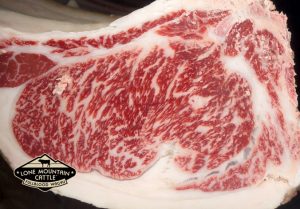Itoshigefuji TF147, linebred to Dai 7 Itozakura, was born 18 September 1995 at Teruo Nakamura’s farm in Okayama, and exported to the US by Takeda Farms in 1997. He was shipped along with five other Takeda breeding bulls: Itoshigenami TF148, Itozuru Doi TF151, Kikuterushige TF150, Kikutsuru Doi TF146, and Mitsuhikokura TF149.
Shogo Takeda, the brilliant Japanese breeder and friend to Western producers of Wagyu, has written extensively about his bull, Itoshigefuji TF147, in the August 2007 issue of the Australian Wagyu Update. Here are some excerpts:
“The Nakamura family is the leading breeder, from generation to generation, in the region of Atetsu-gun, and has been breeding a direct line of Takenotanitsuru, the oldest ‘tsuru’ [cow families] in Japan. Okayama’s original foundation bull, Dai 13 Hanayama, was produced from this Takenotanizuru.” (Note that those original bloodlines trace back over 300 years).
“I visited Nakamura’s farm in 1988 and made a promise to buy a bull calf from the following crossings: Itofuji J483 x Itomichi J1158/Itofuji J483. After visiting his farm, I sent Itomichi J483 semen to Mr. Nakamura. First, a female offspring Dai 30 Noboru was produced. I was not disappointed with this outcome as she proved suitable for ‘Modoshi Kohai’ [back crossing or rotational breeding] with Itofuji to further increase characteristics I was looking for. The first male progeny was born in 1995, which I later named Itoshigefuji.”
“It took me nine years to produce Itoshigefuji TF147. He was bred using Itomichi J1158, Takeda Farm’s famous sire, son of Dai 7 Itozakura. Itomichi was the best son for marbling and growth and one of only seven in more than 1,000 sons of Dai 7 Itozakura to outperform him.”
Dai 30 Noboru, the dam of Itoshigefuji, was sired by Itomichi J1158. Her mother, Dai 10 Noburu 3, was sired by Itofuji J483 – the beginnings of Modoshi Kohai for Takeda-san. Itofuji J483 was born 21 October 1985 at the Furushiro AI Center in Shimane Prefecture, bred by Mr. Kenji Mukugi.
A son of Dai 7 Itozakura and sire of Itoshigefuji TF147, Itofuji was known, according to Kenichi Ono, for “superior daily gain and early maturity. On the other hand, susceptible to Vitamin A deficiency… and thick boned.” According to Buchanan and Suzuki (AWF), “Dai 7 Itozakura led the Japanese Wagyu industry trend to ‘economically well-balanced’ production; combining growth and fertility with acceptable meat quality. He also sired many of the outstanding ‘economical production’ bulls of the current period, including Itofuji.”
Itoshigefuji TF147 is extremely large for a Fullblood Wagyu bull, weighing roughly 2,640 lbs. According to David Blackmore, “Itoshigefuji has been the most valuable bull used in our breeding herd. His progeny’s carcass quality far exceeded the expectations of his pedigree. The strength, constitution, milk and forage ability has left his daughters the best brood cows in our herd.” In addition, TF147 does marble – see picture (8169U).
Itoshigefuji TF147 has a laudable set of BREEDPLAN figures, being a Trait Leader for Growth Traits – 200-Day Weights (+18); 400-Day Weights (+34); and 600-Day Weights (+44) – and for the maternal trait of Milk EBV (+9), in the top 1%, as well as Trait Leader for Rump Fat EBV (+2.4).
Itoshigefuji TF147 is a carrier of CHS Genetic Defects, and free for all other known Wagyu genetic defects.

LMR Itoshigefuji 8169U – TF147 x Yasufuku Jr – 44.00% IMF